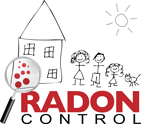RADON CONTROL Canada's Radon Experts
HIGH RADON? CALL 1-888-749-0770

Radon Gas Removal Systems
Radon mitigation in domestic environment is very critical to maintain a healthy indoor environment. Being a naturally occurring carcinogenic, radon is the second major cause of lung cancer in Canada. Therefore, to ensure safety of all family members, it is very important to hire a certified contractor to prevent radon from entering the house and/or to reduce current indoor radon level in everyone’s place.
There is no universal technique of radon mitigation as it depends on the foundation type, ventilation, air flow direction, and underlying materials of a building. Specialist contractor should visit the place for reconnaissance, do all necessary diagnostic tests, and then decide on the technique that would work best for your home.
Foundation type is the single most important factor in deciding effective radon mitigation technique. Foundation of your home can be slab-on-grade type, where basement floors are cast by solid concrete; or the crawlspace type, where shallow unfinished space are kept under the first floor. In some homes, there can be combination of these two foundation type, where coupling of several radon reduction techniques may be needed. Generally radon is being reduced to the maximum allowable radon level below 200 Bq/m3. (becquerel per cubic meter)
Active Sub-slab Depressurization is the most popular radon reduction method, where one or more suction pipes are inserted below the concrete slab to withdraw deposited radon beneath the building. Such suction pipe/pipes are operated mechanically to remove the radon below the buildings that have a basement or a slab-on-grade foundation. If natural air difference drives the air flow through the pipe, this suctioning method is called passive sub-slab suction. The passive method is commonly used in newly constructed homes, where deposited radon level is expected to be low. These methods work best if the air can flow easily beneath the floor material; in ideal operation condition, active and passive suctioning can reduce the radon level up to 99% and 50% respectively.
Block-wall depressurization is the other suctioning method primarily used in homes with hollow block-walls. This method requires sealing of major openings and can remove 50-90% of the radon concentration. If needed, block-wall suction method can be used in combination of active sub-slab depressurization method.
Radon Test KitUsed by professionals and now available to homeowners for only $34.96Radon Mitigation Tools & Equipment
Radon mitigation strategy is different for the crawlspace houses. One of the most popular methods is to cover the earth floor with an air-impermeable plastic sheet. Additionally, vent pipes and/or fans can be used to move radon out of the home; this form of suction is called sub membrane depressurization. Radon fans can also increase the ventilation of the crawled space. Such ventilation lowers the concentration of radon by reducing amount of radon that comes out of the soil and also by diluting the radon outside of the home. These methods can reduce up to 70% of the indoor radon concentration.
In addition to these, sealing, home or room pressurization, air-to-air heat exchanger, and natural ventilation are some other less effective methods to reduce indoor radon level in your home.
Home
Radon Gas
Radon Videos
Radon Related Links
Radon Test Kit
Radon Gas Test
Mitigation - Existing Homes
Mitigation - New Homes
Myths vs. Facts
Canada's Radon Store
Radon Fans
Fan Installation Kits
Flexible Couplings
System Indicators
Radon Fan Accessories
Reduction System T Fitting
Radon Control
1780 West Broadway
PO Box 14047 Delamont Po
VANCOUVER, B.C., V6J 0B9

All rights reserved. 2012 - 2013 Radon Control, Vancouver, BC, CANADA